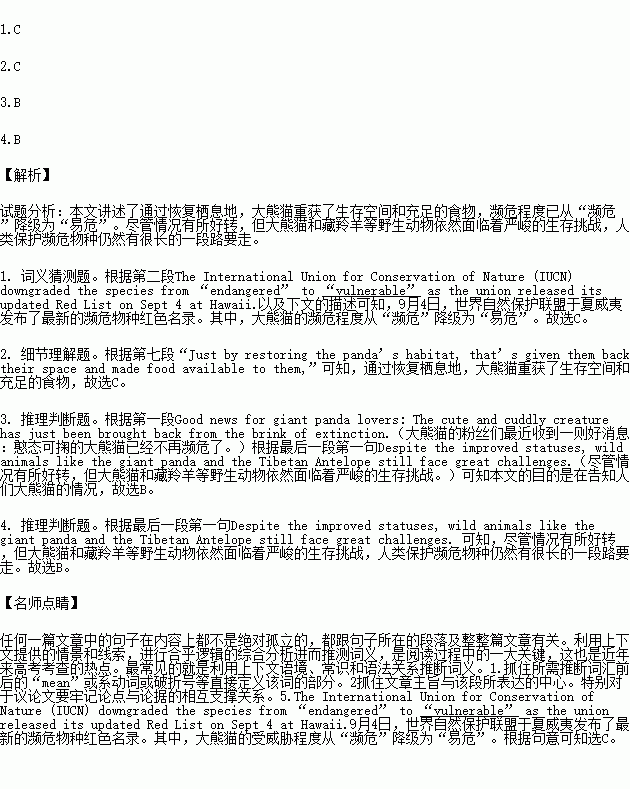题目内容

Good news for giant panda lovers: The cute and cuddly creature has just been brought back from the brink of extinction.
The International Union for Conservation of Nature (IUCN) downgraded the species from “endangered” to “vulnerable” as the union released its updated Red List on Sept 4 at Hawaii.
The downgrade came after IUCN data suggested that there were 1,864 giant pandas in the wild in China in 2014 — their population has grown by 17 percent in the decade leading up to 2014.
Chinese conservation efforts, including forest protection and reforestation, are considered to be the driving force behind the animal’s resurgence.
“It’s all about restoring the habitats,” Craig Hilton-Taylor, head of the IUCN Red List, told the BBC.
The number of panda reserves in China has also jumped to 67, from 13 in 1992. Nearly two-thirds of all wild pandas live in these reserves, according to the World Wildlife Fund.
“Just by restoring the panda’s habitat, that’s given them back their space and made food available to them,” Hilton-Taylor said.
A loss of habitats, on the contrary, was what caused the number of pandas to drop to just over 1,200 in the 1980s, Hilton-Taylor added.
Apart from giant pandas, the Tibetan Antelope has also moved from “endangered” to “near threatened”. According to a statement from IUCN, the animal’s numbers dwindled severely — dropping from around 1 million to an estimated 65,000-72,500 in the 1980s and early 1990s — due to commercial poaching. Rigorous(严格的) protection has since been enforced to protect the beasts and the population is now likely to be between 100,000 and 150,000.
Despite the improved statuses, wild animals like the giant panda and the Tibetan Antelope still face great challenges. The IUCN warned, for example, that ongoing threats from climate change could eliminate more than 35 percent of the panda’s bamboo habitat in the next 80 years, which would reverse the species recent gains.
1.What does the underlined word in pagagraph 1 mean?
A. dangerous and threatened.B. safe and sound.
C. weak and easily hurt.D. normal and common.
2.Which of the following can account for pandas’ living improvement?
A. Better climate.B. More built reserves.
C. Well restored habitats.D. Aroused public awareness.
3.The passage is written in order to ________.
A. convinceB. informC. argueD advocate
4.What does the last paragraph imply?
A. The climate will influence the threatened species.
B. We humans still have a long way to go to protect the endangered species.
C. Pandas will go extinct for lack of abundant food.
D. Habitats for giant pandas will decrease sharply.

